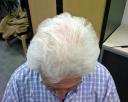18.02.2008
in HAIR LOSS SCIENCE
In this factsheet:
* The Facts on Vitiligo
* Causes of Vitiligo
* Symptoms and Complications of Vitiligo
* Diagnosing Vitiligo
* Treating and Preventing Vitiligo
The Facts on Vitiligo
Affecting 1% to 2% of the population, vitiligo (pronounced “vit-il-eye-go”) is a skin condition in which a loss of pigment causes the skin to appear white (depigmentation). Irregular white patches may occur on any area of the body. Due to the difference between the affected and unaffected areas, this condition is more visible in people with darker skin. The condition can affect anyone.
This condition can also affect mucous membranes and the retina of the eye. The hair that grows in areas affected by vitiligo may also turn white.
Causes of Vitiligo
In the skin, cells called melanocytes produce pigment that gives the skin its colour.Melanin is the pigment produced by the melanocytes. It provides pigmentation for skin, hair, and eyes. When the melanocytes are destroyed, skin cells appear white, and this causes vitiligo.
The reason for the loss of pigment from various parts of the body is not well understood. People with a family history of vitiligo are more likely to have the condition. Vitiligo is also associated with the following diseases:
* pernicious anemia
* hyperthyroidism
* Addison’s disease
Symptoms and Complications of Vitiligo
Symptoms of vitiligo include the appearance of irregular white patches, or various degrees of depigmentation on the body. People often notice the loss of pigment on the following areas first:
* face
* lips
* hands
* arms
* feet
The other areas where white patches due to vitiligo may occur are:
* armpits
* eyes
* genitals
* groin
* navel
* nostrils
Melanin also protects the skin from the sun. Due to the lack of pigmentation in the skin, there is a greater risk for sun sensitivity in affected areas. Vitiligo increases the chance of sunburn and the development of skin cancer in people with the condition.
Vitiligo is not a contagious condition.
Diagnosing Vitiligo
To determine the presence of vitiligo, your doctor will need to perform a physical examination. He or she may also ask about your general health and family history of vitiligo (to see if there is a genetic link). Other factors leading to the onset of vitiligo often include a rash, sunburn, or trauma (e.g., a scrape or wound) to the area where vitiligo is first noticed.
To get a better idea of which skin areas have been affected, your doctor will shine a Wood’s lamp on the affected skin in a dark room. Ultraviolet (UV) light from the Wood’s lamp causes the skin to appear different colours depending on the underlying condition of the skin. With vitiligo, there is no colour and so the skin appears very white, with no pigment. The Wood’s lamp allows doctors to see areas affected by vitiligo that may appear normal under regular light.
To test for conditions or diseases associated with vitiligo, your doctor may take a blood sample to check the:
* blood cell count (related to pernicious anemia)
* TSH function of the thyroid (related to hyperthyroidism)
* number of antinuclear antibodies (ANA) to determine if you have an autoimmune disease (related to Addison’s disease or other autoimmune diseases)
A biopsy of the affected areas may be needed to look at the cells under a microscope. And in some cases, an examination of the eyes may be necessary.
Treating and Preventing Vitiligo
Various types of treatment are available for vitiligo. For people with fair skin, treatment may require that the individual avoid the sun in order to prevent tanning. By doing so, the pigmented skin does not tan, and the affected areas are less noticeable.
For people with a greater contrast between the affected and unaffected areas, the following options exist to help disguise or treat vitilgo:
* make-up
* depigmentation
* repigmentation
* grafting
Waterproof make-up is available in many different colours to match many different skin colours. This is a good choice to effectively cover affected white patches and is safe for everyone including children.
Depigmentation is a treatment in which a person may choose to remove the pigmentation from the unaffected skin areas to better match the affected areas. This is used in cases where vitiligo is extensive. The person uses a cream containing monobenzyl ether of hydroquinone to remove remaining pigment. This process takes a long time to complete, sometimes a year or more. Removal of pigment is permanent
Repigmentation, a treatment that aims to restore pigment in affected areas, is another treatment option for people with vitiligo. Choices for repigmentation include:
* dyes
* self-tanning products
* micro-pigmentation tattooing
* creams containing corticosteroid compounds
* creams containing immunomodulator compounds
* grafting
* phototherapy(psoralen photochemotherapy and narrow band UVB phototherapy)
Stains may be useful to dye the skin a colour that more closely matches the unaffected areas. Certain self-tanning products contain dihydroxyacetone that produces a tan and does not require the melanocytes in the skin to produce melanin. The tan fades over time and must be repeated. Micro-pigmentation tattooing is useful for small white patches associated with vitiligo. This method also adds colour to the white patch.
Two types of cream exist that contain compounds that help repigment the skin. Creams containing corticosteroid compounds are able to help regain pigment in small white patches where vitiligo occurs. Creams containing corticosteroids may damage the skin and must be carefully prescribed. Other creams containing immunomodulator compounds help repigment the white patches.
With grafting, doctors transplant skin to the affected area(s) from another part of the body. However, despite the transplant, pigment does not always return to the vitiligo-affected area.
Psoralen treatment, also called psoralen photochemotherapy (PUVA), uses a combination of a psoralen medication as well as exposure to UVA ultraviolet light. In this process, the person takes psoralen either orally (by mouth) or applies a cream containing psoralen to the skin before exposure to the ultraviolet light. Exposure to ultraviolet light causes a high sensitivity to light and increases the possibility of pigment returning to the affected areas. Many risks are associated with this type of treatment due to the damaging effects of UVA light. Some of the side effects include:
* increased risk of skin cancer
* sunburn
* itching
* hyperpigmentation (dark spots on the skin)
If taking a psoralen medication orally, these additional side effects may occur:
* nausea
* damage to eyes due to light sensitivity
* abnormal hair growth
A dermatologist must closely supervise this treatment. It is not recommended for children under 12 years of age.
Narrow band UVB phototherapy uses UVB light to stimulate repigmentation of the affected areas of skin.
There is no cure for vitiligo. No methods prevent vitiligo but using sunscreens with a minimum of SPF 15 to protect your skin from the sun is always a healthy decision.
Emotional support is another important part of vitiligo therapy. The skin changes caused by vitiligo can affect people emotionally and socially. Joining a support group or seeing a counsellor can help people cope with these effects.
Do you have Hair Loss Problems, read our Hair Loss Help
Useful Links:
http://www.vitiligosociety.org.uk/
http://www.nhsdirect.nhs.uk/articles/article.aspx?articleId=391
http://www.britishskinfoundation.org.uk/standard.aspx?id=166
http://www.patient.co.uk/showdoc/23069065/










